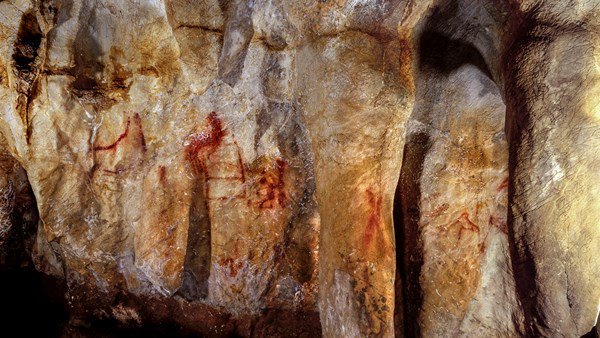The cave art – which dates back 64,000 years – is too old to have been made by modern humans, experts have claimed.
The art was found deep inside three separate caverns in Spain some 700km apart.
Archaeologist and joint lead researcher Dr Chris Standish, from the University of Southampton, said: “Our results show that the paintings we dated are, by far, the oldest known cave art in the world, and were created at least 20,000 years before modern humans arrived in Europe from Africa – therefore they must have been painted by Neanderthals.”
Scientists previously thought it was an “impossible coincidence” that Neanderthals were making cave art at the same time when “modern humans were already in or at the gates of Europe”.
The dating method involved sampling ultra-thin carbonate deposits built up over time on top of the paintings.
Scientists used a method more accurate than carbon dating involving measuring traces of the radioactive element uranium and thorium.
By calculating the relative levels of both elements, scientists can work out precisely how much time has passed, as uranium transforms into thorium by a process of radioactive decay at a precise rate.

As the samples were on top, it indicates that what lies beneath must be older than the deposit.
And in a separate Spanish cave, at Cueva de los Aviones, in south-east Spain scientists have found even older evidence of early decorative art.
Researchers found seashells with drilled holes stained red for use as pendants – dating to 115,000 years ago.
Again the shells can only be the work of Neanderthals.
Professor Alistair Pike, from the University of Southampton, one of the authors of the research, published in Science said: “Ever since Neanderthal fossils were found in the 19th century, they have had a bad press.


“In fact, the original name for Neanderthals was proposed as Homo stupidus, the stupid human.
“And people have portrayed them as incapable of symbolic thought.
“What we have found here is evidence of Neanderthal painting. Not just smearing something on the wall, but painting something on the wall which represents something.”

Neanderthals became extinct around 38,000 years ago for reasons that are still not clear.
Painting is the latest ability likely to be found to have been carried out by Neanderthals.
It is known that Neanderthals lived in large social groups, carried out burials, and survived in the tough conditions of the Ice Age.
Discoveries in Gorham’s cave in Gibraltar dating to 40,000 years ago show a far less sophisticated design – a simple criss-cross pattern engraved in the rocks like a noughts and crosses grid thought to be by Neanderthals – but there was no sign of paint.













